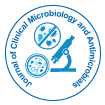
Journal of Clinical Microbiology and Antimicrobials
Open Access
+44-77-2385-9429

+44-77-2385-9429
Opinion Article - (2023)Volume 7, Issue 2
Viral diseases have posed significant challenges to human health throughout history. These diseases are caused by viral pathogens, microscopic infectious agents capable of replicating within living cells. Viruses can infect humans, animals, plants, and even bacteria, resulting in a wide range of diseases and health complications. This article aims in discussing about the nature of viral diseases, their modes of transmission, prevention strategies, and highlight some notable examples.
Understanding viral diseases
Viral diseases arise from a diverse group of viruses, each exhibiting unique characteristics. Unlike bacteria, viruses are not classified as living organisms because they lack the cellular machinery necessary for independent replication. Instead, viruses exploit the cellular machinery of their host organisms, hijacking it to replicate and spread.
The symptoms and severity of viral diseases can vary widely. Some viral infections cause mild symptoms akin to the common cold, while others can lead to severe illnesses such as Ebola or COVID-19. The severity of a viral disease often depends on factors such as the specific virus involved, the individual's immune response, and the availability of medical interventions.
Modes of transmission
Viral diseases can be transmitted through various routes, including direct contact with infected individuals, respiratory droplets, contaminated surfaces, or vectors such as mosquitoes or ticks. The mode of transmission varies depending on the specific virus and its characteristics.
Respiratory viruses, such as influenza or SARS-CoV-2 (the virus responsible for COVID-19), are commonly spread through respiratory droplets generated when an infected person coughs, sneezes, talks, or breathes. Inhalation of these droplets by nearby individuals can result in infection.
Other viruses, like the Human Immunodeficiency Virus (HIV), can be transmitted through direct contact with infected bodily fluids such as blood, semen, vaginal fluids, or breast milk. Transmission can occur through activities such as unprotected sexual intercourse, sharing needles, or mother-to-child transmission during childbirth or breastfeeding.
Prevention and control strategies
Preventing and controlling viral diseases often necessitates a combination of strategies, including vaccination, hygiene practices, vector control, antiviral medications, and public health measures. Vaccination stands out as one of the most effective ways to prevent viral infections. Vaccines stimulate the immune system to produce a targeted response against specific viruses, providing immunity and reducing the risk of infection or severe disease.
Hygiene practices play a crucial role in limiting the spread of viral diseases. Frequent handwashing, covering the mouth and nose when coughing or sneezing, and avoiding close contact with infected individuals can significantly reduce transmission. Vector control measures, such as using insecticides or eliminating mosquito breeding sites, are effective in reducing the transmission of diseases like dengue fever or Zika virus, which are spread by mosquitoes.
Antiviral medications can be employed to treat certain viral infections or alleviate their severity. For instance, Anti-Retroviral Therapy (ART) has substantially improved the prognosis for individuals with HIV/AIDS. However, not all viral infections have specific antiviral treatments, and supportive care often remains the primary approach for managing symptoms and complications.
Notable examples of viral diseases
Throughout history, numerous viral diseases have had significant impacts on human health. Influenza viruses cause seasonal outbreaks of respiratory illness, with symptoms ranging from mild to severe. Influenza pandemics, such as the Spanish flu and the H1N1 pandemic, have had devastating effects worldwide. These pandemics serve as a reminder of the potential dangers posed by viral infections and the importance of preparedness and timely intervention.
HIV/AIDS, caused by the human immunodeficiency virus (HIV), weakens the immune system, leading to acquired immunodeficiency syndrome (AIDS). Since its identification, HIV/AIDS has caused millions of deaths globally and remains a major public health concern. Efforts to combat the spread of HIV/AIDS include raising awareness, promoting safe practices, and providing access to antiretroviral therapy (ART) for affected individuals.
Citation: Lee M (2023) Viral Diseases: Transmission, Prevention, and Notable Examples. J Clin Microbiol Antimicrob. 7:154.
Received: 02-Jun-2023, Manuscript No. JCMA-23-25463; Editor assigned: 06-Jun-2023, Pre QC No. JCMA-23-25463 (PQ); Reviewed: 20-Jun-2023, QC No. JCMA-23-25463; Revised: 28-Jun-2023, Manuscript No. JCMA-23-25463 (R); Published: 06-Jul-2023 , DOI: 10.35248/JCMA.23.7.154
Copyright: © 2023 Lee M. This is an open-access article distributed under the terms of the Creative Commons Attribution License, which permits unrestricted use, distribution, and reproduction in any medium, provided the original author and source are credited.